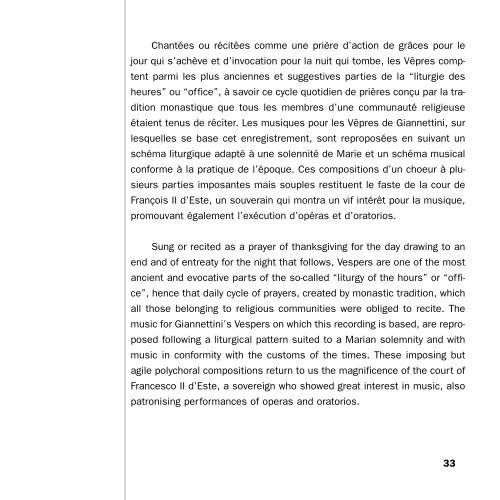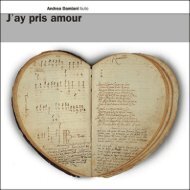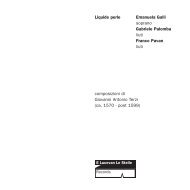Catalogue (PDF, 757 KB) - E lucevan le stelle
Catalogue (PDF, 757 KB) - E lucevan le stelle
Catalogue (PDF, 757 KB) - E lucevan le stelle
You also want an ePaper? Increase the reach of your titles
YUMPU automatically turns print PDFs into web optimized ePapers that Google loves.
Chantées ou récitées comme une prière d’action de grâces pour <strong>le</strong><br />
jour qui s’achève et d’invocation pour la nuit qui tombe, <strong>le</strong>s Vêpres comp-<br />
tent parmi <strong>le</strong>s plus anciennes et suggestives parties de la “liturgie des<br />
heures” ou “office”, à savoir ce cyc<strong>le</strong> quotidien de prières conçu par la tra-<br />
dition monastique que tous <strong>le</strong>s membres d’une communauté religieuse<br />
étaient tenus de réciter. Les musiques pour <strong>le</strong>s Vêpres de Giannettini, sur<br />
<strong>le</strong>squel<strong>le</strong>s se base cet enregistrement, sont reproposées en suivant un<br />
schéma liturgique adapté à une so<strong>le</strong>nnité de Marie et un schéma musical<br />
conforme à la pratique de l’époque. Ces compositions d’un choeur à plu-<br />
sieurs parties imposantes mais soup<strong>le</strong>s restituent <strong>le</strong> faste de la cour de<br />
François II d’Este, un souverain qui montra un vif intérêt pour la musique,<br />
promouvant éga<strong>le</strong>ment l’exécution d’opéras et d’oratorios.<br />
Sung or recited as a prayer of thanksgiving for the day drawing to an<br />
end and of entreaty for the night that follows, Vespers are one of the most<br />
ancient and evocative parts of the so-cal<strong>le</strong>d “liturgy of the hours” or “offi-<br />
ce”, hence that daily cyc<strong>le</strong> of prayers, created by monastic tradition, which<br />
all those belonging to religious communities were obliged to recite. The<br />
music for Giannettini’s Vespers on which this recording is based, are repro-<br />
posed following a liturgical pattern suited to a Marian so<strong>le</strong>mnity and with<br />
music in conformity with the customs of the times. These imposing but<br />
agi<strong>le</strong> polychoral compositions return to us the magnificence of the court of<br />
Francesco II d’Este, a sovereign who showed great interest in music, also<br />
patronising performances of operas and oratorios.<br />
33




